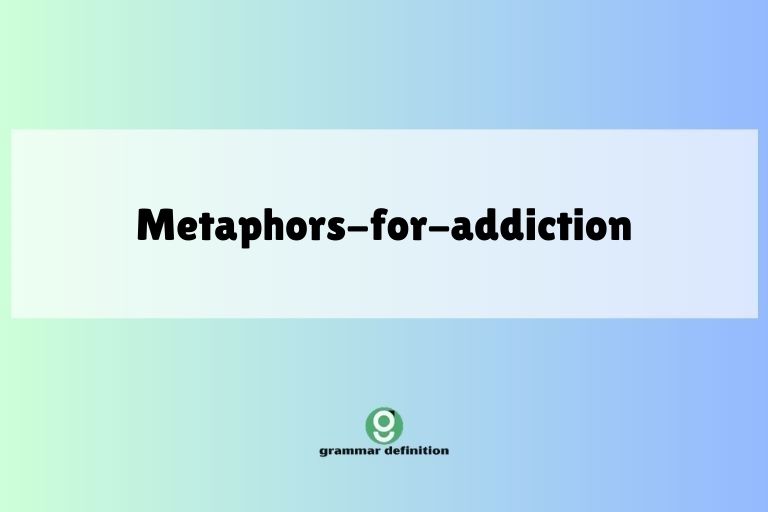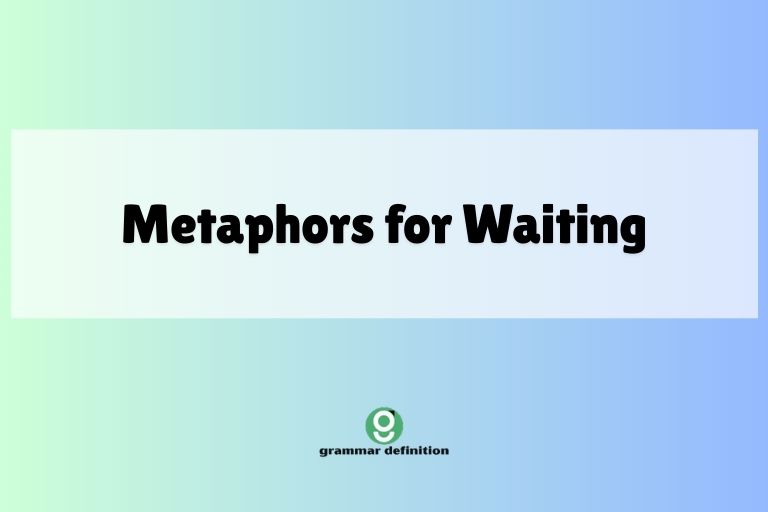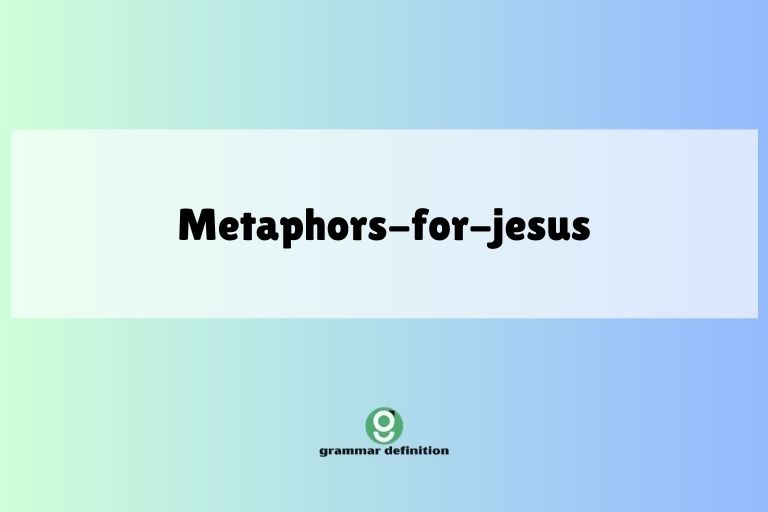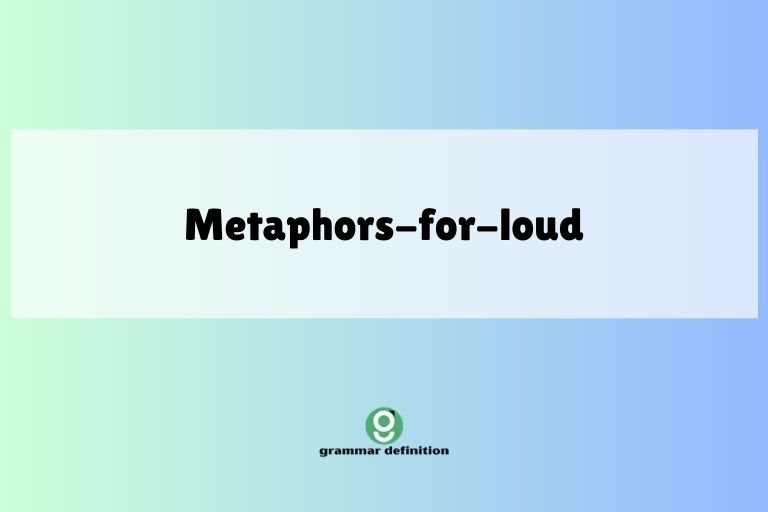Metaphors for Bad Things: A Comprehensive Guide
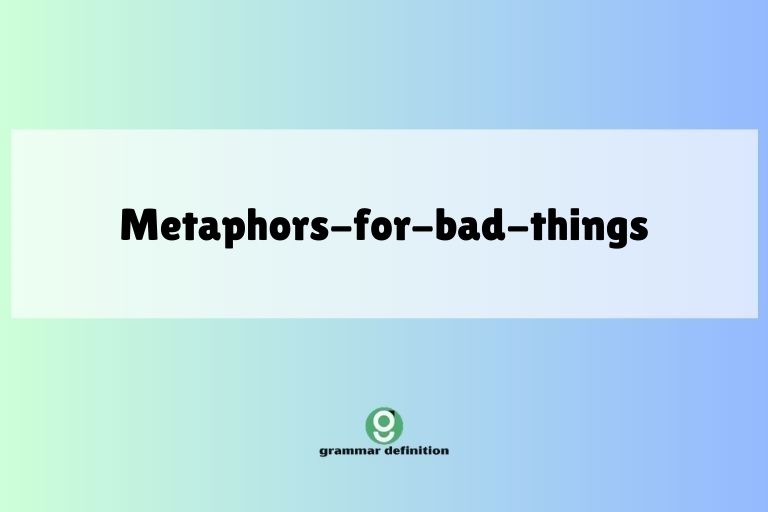
Metaphors are powerful tools that enrich our language and allow us to express complex ideas in vivid and relatable ways. When it comes to describing unpleasant or negative experiences, metaphors can be particularly effective.
Understanding these metaphors not only enhances your comprehension of English but also allows you to communicate more effectively and expressively. This guide is designed for English language learners of all levels, from beginners to advanced speakers, aiming to provide a comprehensive exploration of metaphors used to describe bad things.
Table of Contents
- Introduction
- Definition of Metaphor
- Structural Breakdown of Metaphors
- Types of Metaphors for Bad Things
- Examples of Metaphors for Bad Things
- Usage Rules for Metaphors
- Common Mistakes with Metaphors
- Practice Exercises
- Advanced Topics in Metaphor Usage
- Frequently Asked Questions
- Conclusion
Definition of Metaphor
A metaphor is a figure of speech that directly compares two unrelated things without using “like” or “as.” It asserts that one thing is another, creating a vivid image and implying shared qualities between the two. Metaphors are essential in language because they allow us to understand abstract or complex concepts by relating them to something more concrete and familiar. They add depth, color, and nuance to our communication, making it more engaging and memorable.
The function of a metaphor is to transfer meaning from one domain (the source) to another (the target). For example, if we say “Life is a journey,” we are transferring the qualities of a journey – such as having a path, challenges, and destinations – to the concept of life.
This helps us understand life in a new and insightful way. Metaphors are used extensively in literature, poetry, everyday conversation, and even scientific discourse.
Metaphors thrive in contexts where simple, literal language falls short. When describing emotions, abstract ideas, or complex situations, metaphors provide a shortcut to understanding.
They allow us to convey meaning quickly and effectively, often creating a stronger emotional impact than literal descriptions.
Structural Breakdown of Metaphors
A metaphor essentially has two main components: the tenor (or topic) and the vehicle. The tenor is the subject to which metaphorical attributes are ascribed. The vehicle is the object whose attributes are borrowed. In the example “He is a lion,” “he” is the tenor, and “lion” is the vehicle. The metaphor suggests that “he” possesses qualities associated with lions, such as bravery and strength.
The ground of a metaphor refers to the shared characteristics between the tenor and the vehicle. It is the basis for the comparison. In the “He is a lion” example, the ground is the shared quality of bravery or strength. Identifying the ground is crucial for understanding the meaning and effectiveness of a metaphor.
Metaphors often rely on implicit comparison. The comparison isn’t explicitly stated but is implied through the connection between the tenor and the vehicle.
The success of a metaphor depends on the audience’s ability to recognize these shared qualities and make the connection.
Types of Metaphors for Bad Things
Metaphors for expressing negativity can be categorized into several distinct types, each drawing from different aspects of human experience to convey unpleasant or adverse situations. Here, we explore some of the most common categories:
Natural Disasters
These metaphors compare bad situations to destructive forces of nature, such as hurricanes, earthquakes, or floods. They emphasize the overwhelming and uncontrollable nature of the problem.
Illness and Disease
These metaphors equate negative experiences to sicknesses, highlighting their debilitating and pervasive effects. Terms like “cancer,” “plague,” or “infection” might be used to describe problems that spread and cause significant damage.
War and Conflict
These metaphors depict bad situations as battles, struggles, or conflicts. They emphasize the adversarial nature of the problem and the effort required to overcome it.
Words like “war,” “battle,” or “siege” are common in this category.
Darkness and Shadow
These metaphors use darkness and shadow to represent ignorance, evil, or despair. They highlight the hidden or unclear aspects of a negative situation.
Terms like “darkness,” “shadow,” or “night” are often used.
Burdens and Weights
These metaphors compare bad situations to heavy loads or burdens that weigh someone down. They emphasize the oppressive and exhausting nature of the problem.
Examples include “burden,” “weight,” or “anchor.”
Prisons and Traps
These metaphors portray bad situations as confining or inescapable, like prisons or traps. They emphasize the feeling of being stuck or unable to escape the problem.
Terms like “cage,” “trap,” or “prison” are common.
Examples of Metaphors for Bad Things
Below are examples of metaphors for bad things, categorized by type. Each table provides a range of examples to illustrate how these metaphors are used in different contexts.
Natural Disasters Examples
The following table illustrates metaphors that use natural disasters to describe negative situations. Notice how each metaphor evokes a sense of overwhelming force and destruction.
| Metaphor | Meaning | Example Sentence |
|---|---|---|
| A storm of controversy | A situation filled with intense disagreement and public outcry. | The politician faced a storm of controversy after his remarks were publicized. |
| A tsunami of emotions | An overwhelming surge of feelings. | After the tragic news, a tsunami of emotions washed over her. |
| An earthquake of change | A sudden and dramatic shift that disrupts the status quo. | The new management brought an earthquake of change to the company. |
| A volcanic eruption of anger | A sudden and explosive outburst of rage. | His frustration finally led to a volcanic eruption of anger. |
| Drowning in debt | Being overwhelmed by a large amount of debt. | Many families are drowning in debt due to medical expenses. |
| A whirlwind of problems | A series of problems happening quickly and simultaneously. | She was caught in a whirlwind of problems after losing her job. |
| A landslide victory (used ironically for a defeat) | A complete and overwhelming defeat. | Despite initial optimism, the team suffered a landslide victory for the opposing side. |
| A drought of creativity | A prolonged period lacking in new ideas or inspiration. | The artist experienced a drought of creativity for several months. |
| A flood of complaints | An overwhelming number of grievances or objections. | The company received a flood of complaints after the product launch. |
| A blizzard of paperwork | An overwhelming amount of documents and administrative tasks. | The new regulations created a blizzard of paperwork for everyone. |
| Swept away by the tide of despair | Overwhelmed by feelings of hopelessness. | After several setbacks, he was swept away by the tide of despair. |
| Engulfed by a firestorm of criticism | Subjected to intense and widespread condemnation. | The movie was engulfed by a firestorm of criticism for its offensive content. |
| A hailstorm of accusations | A barrage of accusations coming from multiple directions. | The defendant faced a hailstorm of accusations during the trial. |
| Under the cloud of suspicion | Being suspected of wrongdoing. | He lived under the cloud of suspicion for years after the incident. |
| A torrential downpour of bad news | A sudden and overwhelming influx of negative information. | The company endured a torrential downpour of bad news during the financial crisis. |
| A ripple effect of disaster | A series of negative consequences stemming from a single event. | The factory closure had a ripple effect of disaster on the local economy. |
| Capsized by a wave of adversity | Overcome and defeated by a challenging situation. | The startup was capsized by a wave of adversity when funding fell through. |
| Stuck in the eye of the storm | Being temporarily in a calm period amidst chaos and turmoil. | They were stuck in the eye of the storm, knowing the worst was yet to come. |
| A mudslide of misinformation | A rapid and uncontrolled spread of false or misleading information. | The internet became a mudslide of misinformation during the election. |
| Buried under an avalanche of problems | Overwhelmed and unable to cope with a large number of issues. | The project was buried under an avalanche of problems from the start. |
Illness and Disease Examples
This table presents metaphors that use illness and disease to describe negative situations. These metaphors often highlight the spreading and debilitating nature of the problem.
| Metaphor | Meaning | Example Sentence |
|---|---|---|
| A cancer on society | Something that is destructive and harmful to society. | Corruption is a cancer on society, eroding trust and justice. |
| An epidemic of fear | A widespread and rapidly spreading sense of fear. | The rumors triggered an epidemic of fear throughout the community. |
| Infected with doubt | Filled with uncertainty and skepticism. | His mind was infected with doubt after hearing the conflicting stories. |
| A plague of dishonesty | A widespread and pervasive lack of integrity. | The company was struggling with a plague of dishonesty among its employees. |
| The disease of greed | The destructive and corrupting influence of excessive desire for wealth or power. | The disease of greed led to the company’s downfall. |
| Suffering from a bout of pessimism | Experiencing a period of negative thinking and hopelessness. | He was suffering from a bout of pessimism after the project failed. |
| Paralyzed by anxiety | Unable to act due to overwhelming anxiety. | She was paralyzed by anxiety before the important presentation. |
| A relapse into bad habits | A return to previously abandoned negative behaviors. | He experienced a relapse into bad habits after a period of sobriety. |
| The virus of misinformation | False or inaccurate information that spreads rapidly and causes harm. | The virus of misinformation spread quickly online, causing confusion and panic. |
| A chronic lack of funding | A persistent and ongoing shortage of financial resources. | The project suffered from a chronic lack of funding. |
| Wounded by betrayal | Deeply hurt and affected by someone’s disloyalty. | She was deeply wounded by betrayal from her closest friend. |
| A festering resentment | A growing and unresolved feeling of bitterness and anger. | A festering resentment developed between the siblings. |
| Crippled by self-doubt | Incapacitated by a lack of confidence in oneself. | He was crippled by self-doubt, preventing him from pursuing his dreams. |
| A malignant influence | A harmful and destructive force. | His presence had a malignant influence on the group. |
| Afflicted with apathy | Affected by a lack of interest or concern. | The community was afflicted with apathy after years of political corruption. |
| A debilitating sense of loneliness | An overwhelming and weakening feeling of being alone. | She experienced a debilitating sense of loneliness after moving to a new city. |
| Plagued by nightmares | Constantly disturbed by frightening dreams. | He was plagued by nightmares after the traumatic event. |
| The cancer of prejudice | The deeply ingrained and destructive nature of bias and discrimination. | The cancer of prejudice continues to affect societies worldwide. |
| In remission from despair | Experiencing a temporary relief from feelings of hopelessness. | After finding new purpose, she felt in remission from despair. |
| The toxicity of gossip | The harmful and poisonous effect of spreading rumors and negative talk. | The toxicity of gossip can destroy relationships and reputations. |
War and Conflict Examples
The following table lists metaphors using war and conflict to describe negative situations. These metaphors emphasize struggle, opposition, and the need for resilience.
| Metaphor | Meaning | Example Sentence |
|---|---|---|
| A battle against poverty | A struggle to overcome poverty. | The community is engaged in a battle against poverty. |
| A war of attrition | A conflict where success depends on wearing down the opponent. | The negotiation became a war of attrition, with neither side willing to concede. |
| Under siege from critics | Facing intense and sustained criticism. | The company was under siege from critics after the scandal. |
| Bombarded with questions | Overwhelmed with a large number of questions. | The speaker was bombarded with questions after the presentation. |
| Locked in a struggle | Engaged in a difficult and prolonged conflict. | The two companies were locked in a struggle for market dominance. |
| Fighting a losing battle | Trying to overcome a challenge that is likely to result in failure. | He felt like he was fighting a losing battle against his addiction. |
| Caught in the crossfire | Affected by a conflict in which one is not directly involved. | The innocent bystanders were caught in the crossfire of the gang war. |
| A clash of ideologies | A conflict between opposing sets of beliefs or principles. | The debate was a clash of ideologies between conservatives and liberals. |
| A hostile takeover | An acquisition of a company against the wishes of its management. | The company faced a hostile takeover attempt. |
| Sabotaged by internal conflicts | Undermined by conflicts within the organization. | The project was sabotaged by internal conflicts. |
| Navigating a minefield of issues | Dealing with a situation filled with potential dangers and problems. | The diplomat was navigating a minefield of issues during the peace talks. |
| A strategic retreat | A planned withdrawal to regroup and reassess. | The company announced a strategic retreat from the European market. |
| Besieged by doubts | Surrounded and overwhelmed by feelings of uncertainty. | She was besieged by doubts about her career choice. |
| Waging a war on ignorance | Actively working to combat a lack of knowledge or understanding. | The organization is waging a war on ignorance through education programs. |
| A battlefield of opinions | A situation where conflicting viewpoints clash intensely. | The online forum became a battlefield of opinions. |
| An ongoing skirmish with bureaucracy | A continuous and frustrating struggle with administrative procedures. | The small business owner had an ongoing skirmish with bureaucracy. |
| A coup against tradition | A sudden and forceful overthrow of established customs or practices. | The new CEO staged a coup against tradition within the company. |
| In the trenches of customer service | Dealing with the difficult and demanding aspects of customer support. | The customer service representatives were in the trenches of customer service all day. |
| A cold war of silence | A strained relationship characterized by a lack of communication. | A cold war of silence developed between the neighbors. |
| Armed with determination | Equipped with strong resolve and purpose. | She was armed with determination to overcome the challenges ahead. |
Darkness and Shadow Examples
This table provides metaphors that use darkness and shadow to describe negative situations. These metaphors often highlight the hidden, mysterious, or ominous aspects of the problem.
| Metaphor | Meaning | Example Sentence |
|---|---|---|
| A dark cloud hanging over | A sense of impending doom or negativity. | A dark cloud was hanging over the company due to the financial troubles. |
| Living in the shadows | Existing in obscurity or secrecy. | The criminal was living in the shadows, avoiding detection. |
| A shadowy figure | Someone with a mysterious or suspicious nature. | He described the suspect as a shadowy figure lurking near the building. |
| The darkness of despair | A profound feeling of hopelessness and sadness. | She was lost in the darkness of despair after losing her job. |
| A hidden agenda | A secret plan or motive. | His actions suggested he had a hidden agenda. |
| A murky situation | A situation that is unclear and difficult to understand. | The details of the agreement remained murky. |
| Overshadowed by doubt | Dominated or influenced by feelings of uncertainty. | His achievements were overshadowed by doubt after the allegations. |
| Lost in the darkness of ignorance | Lacking knowledge or understanding. | They were lost in the darkness of ignorance about the consequences of their actions. |
| A veil of secrecy | A cover or concealment of information. | A veil of secrecy surrounded the project. |
| The shadow of the past | Negative events or experiences that continue to affect the present. | The shadow of the past still haunted him. |
| A twilight of hope | A fading or diminishing sense of optimism. | In the twilight of hope, they clung to any possibility of rescue. |
| Plunged into darkness | Suddenly thrust into a state of ignorance or despair. | The city was plunged into darkness during the blackout. |
| A penumbra of uncertainty | A surrounding area of doubt or ambiguity. | A penumbra of uncertainty lingered around the new policy. |
| The eclipse of reason | A temporary loss of rational thought or judgment. | The crowd experienced an eclipse of reason during the riot. |
| A dark chapter in history | A period marked by negative events or actions. | The war was a dark chapter in history. |
| Shrouded in mystery | Covered or concealed in a way that is difficult to understand. | The origins of the artifact remained shrouded in mystery. |
| A black mark on his record | A negative event that damages one’s reputation. | The scandal left a black mark on his record. |
| The abyss of despair | A bottomless pit of hopelessness and sadness. | He stared into the abyss of despair after losing everything. |
| A glimmer of hope in the darkness | A small indication of optimism amidst a negative situation. | There was a glimmer of hope in the darkness. |
| Lost in the labyrinth of bureaucracy | Confused and disoriented by complex administrative processes. | He was lost in the labyrinth of bureaucracy. |
Burdens and Weights Examples
The table below contains metaphors using burdens and weights to describe negative situations. These metaphors emphasize the oppressive, exhausting, and limiting nature of the problem.
| Metaphor | Meaning | Example Sentence |
|---|---|---|
| Carrying the weight of the world | Feeling an overwhelming sense of responsibility and burden. | She felt like she was carrying the weight of the world on her shoulders. |
| A heavy burden to bear | A difficult or painful responsibility to endure. | The secret was a heavy burden to bear. |
| Weighed down by guilt | Feeling oppressed by feelings of remorse or culpability. | He was weighed down by guilt after the accident. |
| An anchor holding back progress | Something that impedes or slows down advancement. | The outdated technology was an anchor holding back progress. |
| Saddled with debt | Burdened with a large amount of debt. | The company was saddled with debt after the failed investment. |
| A millstone around the neck | A heavy burden or responsibility that is difficult to manage. | The failing business was a millstone around his neck. |
| Struggling under the yoke of oppression | Enduring harsh and unjust treatment. | The people were struggling under the yoke of oppression. |
| Held back by invisible chains | Restrained by unseen forces or limitations. | She felt held back by invisible chains. |
| A load off one’s mind | A relief from worry or stress. | It was a load off her mind when she finished the project. |
| Crushed by expectations | Overwhelmed by the pressure to meet certain standards. | He was crushed by expectations from his family. |
| The albatross around his neck | A constant burden or reminder of a mistake. | The scandal became the albatross around his neck. |
| Bow down by sorrow | Overwhelmed and defeated by grief. | She was bowed down by sorrow after the loss of her husband. |
| A crushing blow to morale | A devastating event that lowers spirits and enthusiasm. | The news was a crushing blow to morale. |
| Dragging one’s feet through life | Living without enthusiasm or purpose. | He felt like he was dragging his feet through life. |
| Burdened by a guilty conscience | Feeling weighed down by remorse for one’s actions. | He was burdened by a guilty conscience. |
| A heavy heart | A feeling of sadness or sorrow. | She had a heavy heart after the argument. |
| The weight of responsibility | The burden of having to make important decisions and be accountable. | He felt the weight of responsibility as the team leader. |
| Sinking under the pressure | Failing to cope with overwhelming stress. | She felt like she was sinking under the pressure. |
| A cumbersome task | A difficult and time-consuming job. | The paperwork was a cumbersome task. |
| Bent under the weight of age | Physically and emotionally weakened by the passage of time. | He was bent under the weight of age. |
Prisons and Traps Examples
The following table provides metaphors that use prisons and traps to describe negative situations. These metaphors emphasize the feeling of being confined, restricted, or unable to escape.
| Metaphor | Meaning | Example Sentence |
|---|---|---|
| Trapped in a dead-end job | Feeling stuck in a job with no opportunities for advancement. | He felt trapped in a dead-end job. |
| Living in a gilded cage | Having a luxurious but restrictive life. | She was living in a gilded cage, surrounded by wealth but lacking freedom. |
| Confined by expectations | Restricted by the expectations of others. | He felt confined by expectations from his family. |
| A prisoner of one’s own fears | Restrained by one’s own anxieties and insecurities. | She was a prisoner of her own fears. |
| Caught in a web of lies | Entangled in a complex and deceitful situation. | He was caught in a web of lies. |
| Imprisoned by self-doubt | Restrained by a lack of confidence in oneself. | She felt imprisoned by self-doubt. |
| Stuck in a rut | Being in a monotonous and unfulfilling routine. | He felt stuck in a rut. |
| Cornered by circumstances | Forced into a difficult or inescapable situation. | He was cornered by circumstances. |
| Ensnared by addiction | Trapped by a compulsive behavior. | He was ensnared by addiction. |
| Shackled by tradition | Restrained by established customs and practices. | They felt shackled by tradition. |
| A cage of one’s own making | A self-imposed limitation or restriction. | He had created a cage of his own making. |
| Lost in the maze of bureaucracy | Confused and disoriented by complex administrative processes. | She was lost in the maze of bureaucracy. |
| Trapped in a cycle of poverty | Unable to escape a continuous pattern of financial hardship. | They were trapped in a cycle of poverty. |
| Confined to a wheelchair (used metaphorically for any restriction) | Limited in one’s activities or opportunities. | His lack of education confined him to a life of low-paying jobs. |
| Fenced in by regulations | Restricted by rules and laws. | The business felt fenced in by regulations. |
| Hemmed in by responsibilities | Restricted by obligations and duties. | She felt hemmed in by responsibilities. |
| In a bind | In a difficult or inescapable situation. | He was in a bind after losing his job and his savings. |
| Walking on eggshells | Being extremely cautious to avoid causing offense or problems. | She felt like she was always walking on eggshells around her boss. |
| Caught between a rock and a hard place | Faced with two equally unpleasant alternatives. | He was caught between a rock and a hard place. |
| Boxed in by circumstances | Limited or restricted by the situation one is in. | They felt boxed in by circumstances. |
Usage Rules for Metaphors
Using metaphors effectively requires a good understanding of context and audience. Here are some important rules to keep in mind:
- Clarity: The metaphor should enhance understanding, not confuse the reader. Choose metaphors that are relatable and easy to grasp.
- Relevance: The connection between the tenor and the vehicle should be clear and logical. The shared qualities should be apparent.
- Originality: While common metaphors can be effective, strive for originality to make your writing more engaging and memorable. Avoid clichés.
- Consistency: Avoid mixing metaphors within the same context. This can create confusion and undermine the impact of your message.
- Appropriateness: Consider the tone and formality of the situation. Some metaphors may be inappropriate in certain contexts.
Common Mistakes with Metaphors
Here are some common mistakes to avoid when using metaphors:
- Mixed Metaphors: Combining incompatible metaphors that create a nonsensical image.
- Incorrect: “We must nip it in the bud before it snowballs into a full-blown crisis.” (Mixing plant growth and snowballing).
- Correct: “We must nip it in the bud before it becomes a major problem.”
- Clichés: Using overused and unoriginal metaphors that have lost their impact.
- Incorrect: “He was as brave as a lion.” (Overused and predictable).
- Correct: “His courage was a fortress, unshaken by the storm of adversity.”
- Inappropriate Metaphors: Using metaphors that are unsuitable for the context or audience.
- Incorrect: Describing a solemn event with a lighthearted or humorous metaphor.
- Correct: Using respectful and somber language that aligns with the event’s gravity.
- Overuse: Using too many metaphors, which can make your writing feel forced or unnatural.
- Incorrect: “The project was a rollercoaster, a tempest, a raging inferno of challenges.”
- Correct: “The project presented numerous significant challenges.”
- Lack of Clarity: Using metaphors that are too abstract or obscure, making it difficult for the reader to understand the intended meaning.
- Incorrect: “His mind was a tessellation of thought.”
- Correct: “His thoughts were complex and interconnected.”
Practice Exercises
Test your understanding of metaphors with these exercises:
Exercise 1: Identify the Metaphor
Identify the metaphor in each sentence and explain its meaning.
- Her anger was a simmering volcano.
- The city is a concrete jungle.
- He is a shining star in the company.
Answers
- Metaphor: “simmering volcano.” Meaning: Her anger was building up and could erupt at any moment.
- Metaphor: “concrete jungle.” Meaning: The city is harsh, impersonal, and lacking in natural beauty.
- Metaphor: “shining star.” Meaning: He is exceptionally talented and successful in the company.
Exercise 2: Create Your Own Metaphor
Create a metaphor to describe each of the following:
- Fear
- Hope
- Failure
Possible Answers
- Fear: Fear is a dark shadow that clings to your heels.
- Hope: Hope is a fragile seedling pushing through concrete.
- Failure: Failure is a detour on the road to success.
Exercise 3: Correct the Mixed Metaphor
Correct the following sentences to eliminate mixed metaphors:
- We need to put the fire out before it snowballs.
- The project is a tightrope walk on thin ice.
- His argument was a house of cards that nipped the problem in the bud.
Possible Answers
- We need to put the fire out before it spreads.
- The project is a risky endeavor.
- His argument was weak and easily dismantled.
Advanced Topics in Metaphor Usage
For advanced learners, exploring the theoretical underpinnings of metaphor can further refine their understanding and usage. Areas such as Conceptual Metaphor Theory, which examines how abstract concepts are understood through more concrete ones, can provide deeper insights.
Additionally, studying the use of extended metaphors, where a single metaphor is developed throughout a piece of writing, can enhance expressive capabilities. Analyzing how metaphors function in different genres and cultural contexts also offers a broader perspective on their effectiveness and appropriateness.
Frequently Asked Questions
What is the difference between a metaphor and a simile?
A metaphor directly equates two things (e.g., “He is a lion”), while a simile uses “like” or “as” to make a comparison (e.g., “He is as brave as a lion”).
Can a metaphor be too subtle?
Yes, if the connection between the tenor and the vehicle is too obscure, the metaphor may not be effective.
How can I improve my use of metaphors?
Read widely, pay attention to how skilled writers use metaphors, and practice creating your own.
Are there any metaphors that should always be avoided?
Avoid clichés and metaphors that are offensive or inappropriate for your audience.
Why are metaphors important in language learning?
Metaphors enhance understanding, add depth to communication, and make language more engaging and memorable.
Conclusion
Mastering the use of metaphors for bad things is a valuable skill for any English language learner. By understanding the different types of metaphors, avoiding common mistakes, and practicing their usage, you can significantly enhance your ability to express complex ideas in vivid and impactful ways.
Continue to explore and experiment with metaphors to enrich your language and communicate more effectively.

